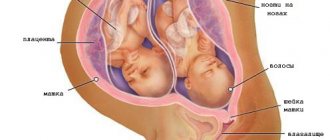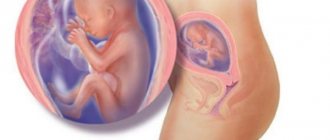When does the baby start to move? Obstetric norms
The baby in the mother’s tummy begins to move long before she can feel it. The baby's first movements occur 8-9 weeks after conception.
During this period of development, the baby’s body begins to acquire bundles of muscles and neurons, but the nervous system is still in its “infancy”, so the child’s first movements resemble convulsive contractions.
Naturally, the mother cannot feel such minor “shocks”, because at this moment the baby is still very tiny - it weighs only 3.5 grams, and in outline it resembles a berry rather than a child.
By the 12th week of pregnancy, the baby's arms and legs are formed, his motor activity increases, he begins to tumble and push, but the mother still cannot feel this due to the small size of the fetus.
By week 16, the fetus has developed facial features and can already distinguish sounds and respond to them. In addition, the baby gets stronger, his movements become more confident, and there is less and less space for him in the amniotic sac. But during the first pregnancy, a woman will be able to feel the confident “pushes” of the baby only in the 5th month - approximately 18-20 weeks.
First tremors
At what weeks does the baby begin to move so that the mother can feel his kicks? There is no exact answer. If a woman is carrying a baby for the first time, this occurs at approximately 20 weeks. During the second pregnancy, movement can be felt a little earlier, at 17-18 weeks. These terms are approximate and may deviate more or less. This happens for various reasons.
All future future people eagerly await the movement of the first child in their womb, especially the firstborn, for whom all the issues of pregnancy are a complete new thing. From the moment you first feel the baby moving in your belly, you will have this feeling for the rest of your pregnancy. Gentle at first, the waves will soon turn into a solid blow that is sure to leave you breathless and at the same time they will make you smile.
Baby's first step to feel around the week of pregnancy. In their case, there is a high probability that the baby's sensitive movements are much earlier, but they cannot distinguish them from their body's natural reactions, such as the functioning of the digestive tract.
- Much depends on the individual sensitivity of the woman.
- You can make a mistake when calculating the gestational age.
- Sometimes the fat layer on the belly of the expectant mother prevents you from feeling light tremors.
The second child develops just like the first. A multiparous mother notices movements faster because she has experienced these sensations before. Inexperienced women often do not pay attention to them, mistaking them for seething in the intestines.
The mother's baby's first stroke usually appears around the week of pregnancy. The child begins to move much earlier than his mother feels. But the child is too young for her mother to feel it. Only when you grow up are you ready to know that you are patient and waiting for peace to come.
In the beginning, the baby's movement is a very delicate thing that a pregnant woman compared to the bubbling, tickling, stomach-like feeling that was a sparkling drink or a tiny swimming fish. Over time they will become more pronounced. As your child grows up, you will soon be giving him an energetic dance in your interior. Your belly will take on incredible shapes and you'll laugh at the fact that you're in the middle of a little alien.
It happens differently. Some mothers claim that the baby begins to move at 12 or 14 weeks. Experts believe that this is impossible. The fruit has not yet formed to the size where its beating can be felt. Most likely, problems in the intestines are making themselves felt.
In order not to miss when the baby begins to move in the stomach, listen to yourself from the 16th week.
It has plenty of room to play. Turns from all sides, takes any position, moves from one side of the abdomen to the other. His small home becomes tense over the next few weeks. After 30 weeks of pregnancy, your baby's movements are clearly systematized, you know what situations and when to expect them. A baby's greatest activity is when their mother is resting. Immobility awakens the baby, who sleeps when he is rocked by his mother's activity.
After a week of pregnancy, observe the baby's movements. See how many moves a child takes in an hour and how long it takes him to complete ten moves. Your doctor may ask you to make daily observations. This should quickly spot any warning signs.
At first you may feel light, gentle touches inside yourself. What are they, how can they begin? They say touch is reminiscent of the beating of a butterfly's wings or the swimming of a tiny fish. The first shocks are not sharp and strong, so they are easy to miss. They are vaguely similar to intestinal peristalsis.
Having felt the movement, the woman must remember at how many weeks the baby began to move, and tell the specialist about this when visiting the consultation. Using this indicator, the doctor calculates the expected day of birth. If a woman is carrying a child for the first time, 20 weeks are added to the date; for a multiparous mother, 22 weeks are added. It is difficult to say how accurate such a calculation will be. But together with ultrasound data and the date of the last menstruation, it helps to calculate the long-awaited day of the birth of the baby.
When should you feel your baby's first steps?
A pregnant baby's first step is usually a very touching moment. It is also obvious that there is someone living near our belly. When can you expect the first strikes? In fact, the baby begins to become active very early in pregnancy, around one week. Only one month of pregnancy is a time of very high activity - the baby "dances", suspended in the amniotic fluid sac, hips swaying, turning a leg, grabbing legs, tilting elbows, frowning, scratching, making grimaces, opening and closing the mouth.
Second/third child
According to the experience of many women, during their second and third pregnancies, you can feel the baby’s movements a little earlier, at 17-18 weeks.
The fact is that women pregnant with their first child often confuse timid fetal points with problems with intestinal motility, and do not understand that the baby has already begun to give signals.
Although fetal development does not depend on the number of pregnancies, experienced mothers already know when the baby can begin to move, and they look forward to this moment.
Early fetal movements
Is it possible? Many first-time pregnant women expect the first signs of the baby's movement already at the twelfth week.
Did you feel any movement? Only this is not a child, these are accumulated gases and displacement of organs due to the increasing size of the uterus.
At what point does the baby begin to move - namely, from the eighteenth week to the twenty-second - fetal movements are more often noticed. You may be kicked with an elbow or knee.
Multiparous pregnant women may feel movements earlier - at the sixteenth week. Why? Because the mother’s body has experience and physical preparation for pregnancy and childbirth. The abdominal wall remembers how to stretch, the familiar sensations of fetal movement - the framework tightens for a week or more. Even in your third pregnancy, you can feel fetal movement at the fifteenth week.
What does the movement feel like? The expectant mother senses the motor activity of the fetus due to the influence of mechanoreceptors. Initially, symptoms may be subtle. Closer to the twentieth week you will feel everything more acutely.
- Butterflies fluttering in the stomach
- Tickling or stroking the inner wall
- Wave-like movements in the abdominal area
- Shocks from small range to large in strength
- Gurgling sensations in the stomach
Character of the sensations: what do the tremors feel like?
What do baby kicks feel like? A woman who is pregnant for the first time certainly thinks about what the baby’s movements and kicks are like, and how to recognize them, because she has never experienced anything like it. In fact, the first movements of the baby are described by expectant mothers in different ways:
- Some people feel a slight stroking from inside the abdomen;
- Some people compare the sensation to a fish swimming;
- Some people feel like butterflies are fluttering inside their stomach;
- Most often, the baby's activity can be confused with gurgling in the stomach.
The baby’s “pushes” can be felt especially clearly while lying on his back. In this position, you can even notice how the stomach seems to be “shaking” due to the baby’s actions.
If the baby’s first timid kicks can still be confused with intestinal activity, then in the later stages the movements become more pronounced: the baby begins to roll over to take a comfortable position, while “kicking” the mother with his legs and arms. The baby can also turn his head, play with the umbilical cord and even suck his fingers, including his toes.
From time to time, the expectant mother, instead of single tremors, may feel a rhythmic movement of the entire abdomen, which can frighten her. Gynecologists say that there is nothing wrong with this - the baby simply swallows amniotic fluid.
At the 6th month of pregnancy, the future father can also feel the movements of the baby: to do this, he will have to put his ear to his stomach. Subsequently, for “contact” with the child, touching the stomach with your hand will be enough.
When does the baby begin to move during the first pregnancy?
Children begin to move at the same gestational period, regardless of whether the mother is carrying her first child or is pregnant again. The only difference is the time when the woman herself begins to feel the vibrations of the embryo in the womb.
For most primigravidas, the first movement of the baby is felt at the 20th week of obstetric gestation. By counting 20 weeks from the day of the first intrauterine movements of the embryo, you can calculate the approximate date of birth. This method is inaccurate. It is used only as a supplement to the main methods of calculating the time of delivery.
How to understand the first fetal movements during your first pregnancy
At first, the movements of the embryo are quite timid and chaotic. When the baby moves for the first time, it is easy to confuse this with bowel movements or gas movement. As the frequency and intensity of these phenomena increases, confidence increases that the baby is beginning to kick in the stomach.
There comes a moment when the baby’s movements are felt so clearly that they cannot be confused with the vital functions of the mother’s body.
Soon the time comes when you can feel the fetus moving even by simply touching the abdomen with your hand.
Where are the first baby movements felt during pregnancy?
When the baby’s first movements are felt, its size is not yet sufficient to fix its position in the uterus, so movements can be felt in any area of the abdomen. At 30-32 weeks, the position of the embryo becomes constant: either head down (cephalic presentation) or feet down (breech presentation). Movements are felt where the legs of the fetus are located: at the top of the peritoneum - with a cephalic presentation and at the bottom - with a pelvic presentation.
How to recognize the first fetal movement during your first pregnancy
When some processes occur in the abdomen, but the woman does not know whether they are related to the movement of the child or whether it is the work of her digestive tract, it is worth drinking a glass of milk and lying on her back. A calm posture and a fresh dose of energy create the conditions when the baby begins to move in the stomach. This is evidenced by the mobility of the surface of the peritoneum, which is visible visually, in combination with internal sensations of movement.
When you feel pain when the baby moves during your first pregnancy
When movements begin, the pregnant woman sometimes experiences pain. Often the reasons lie in the state of her own health. So, unpleasant sensations arise if there are such pathologies:
- Gallbladder disease, such as stones. In this case, the pain is focused under the ribs on the right.
- Diaphragmatic hernia – causes pain under the breast.
Pain in the bladder area does not always indicate pathology. Perhaps the future child is putting a lot of pressure on him. But sometimes such pain indicates the development of inflammation (cystitis). A general blood test helps determine this disorder.
In these cases, it is necessary to notify the doctor managing the pregnancy about pain in order to undergo additional examinations and exclude these pathologies.
Sometimes painful sensations are caused by too strong fetal shocks. This happens if a woman takes a position in which the baby is uncomfortable or the blood flow through the umbilical cord is obstructed, for example, lying on her back or sitting upright with her legs crossed. In this case, you need to change your position, relax, and take a few deep breaths. The fetus will calm down and the pain will go away.
The intensity of the pain depends on how long it is felt: the larger the fetus, the more discomfort its movement can cause.
In what cases should you consult a doctor immediately?
It is important to control at what stage of pregnancy the baby begins to move. If at week 24 the embryo has not yet made itself known, you need to inform your doctor about it.
From the 28th week, the movements of the embryo become permanent. From this time on, fetal motor activity should be monitored. Moving is the only way available to a child to signal the occurrence of problems. You should immediately consult a doctor if the nature of movements, intensity has changed, or if the embryo has quieted down for a long period (12 hours or more).
How many times and how often does the child “kick”?
Starting from the 24th week of pregnancy, the baby begins to actively communicate with his mother in the only way available to him - movement. And the expectant mother must learn to understand him, because a lot can be judged by the baby’s behavior.
With the help of his movements, the baby can: convey his mood - communicate joy or anxiety, talk about his well-being, and even show his “character”.
The baby's movements in the abdomen are also a proven method of self-diagnosis - based on a decrease or increase in the baby's activity, the mother should determine his well-being and, if necessary, notify the doctor.
The rate of fetal movement at 6 months is 10-15 movements per hour, with breaks of 3-4 hours allowed when the child is sleeping. The lack of movement of the baby for 12 hours is a very alarming indicator; you should immediately consult a doctor.
Why does the fetus kick?
At what month of pregnancy does the baby begin to move? In the initial trimester, the fetus grows and develops week by week, and with it comes movement and the desire to “dance” in the womb. As the child's size increases, within certain time limits the baby's first movements and first movements are possible.
Factors that influence fetal movements are:
- The atmosphere, quiet or loud around, familiar or unfamiliar voices.
- Lifestyle. Is your accent active or passive? After all, the more active you are during the day, the more active your baby is at night.
- Psycho-emotional stress: stress, fatigue, overwork, drowsiness and anxiety - your baby will behave more active and painful sensations may appear during fetal movements.
- Diet - hunger or overeating affects the baby, causing him to be hyperactive or, conversely, hypoactive.
- Body position in space. When you take a body position that is uncomfortable for you, you can press down the vessels that saturate the fetus with oxygen. Due to possible hypoxia, the fetus begins to show excessive activity.
How and why to monitor your baby's activity?
Gynecologists recommend that all expectant mothers, starting from the 27th week of pregnancy, monitor the frequency of the baby’s movements and record these indicators in a special journal.
These data will allow the doctor to assess the condition of the fetus and, at the slightest suspicion of pathology, prescribe additional examinations.
Most often, D. Pearson's method is used to monitor the baby's movements, which is based on the mother keeping a special calendar, starting from the 28th week of pregnancy.
The method consists of observing the baby’s movements from 9 am to 9 pm, and the time of every 1st and 10th movement of the child is recorded in the journal.
What the results say:
- If the interval between the baby’s first and tenth movements is 20 minutes, the baby is developing normally and there is nothing to worry about;
- A period of 30-40 minutes is also acceptable - at this time the baby can rest or he simply has a calm character;
- If more than an hour has passed from the first to the 10th shock, the mother should consult a doctor for advice.
Third pregnancy
No matter how long the pregnancy is, mothers are still interested in the baby’s first movement. Before 18 weeks, no mother will feel the tremors. This is basically impossible. Although there are cases when pregnant women claimed that they felt tremors at 16 or 17 weeks. Doctors call this self-hypnosis.
During the third pregnancy, women in labor are not so worried about the activity of the intrauterine fetus. One might even say they listen less. They know that there is no point in expecting anything ahead of schedule.
The task of mothers is to visit the gynecologist in a timely manner and undergo tests. If you have the slightest doubt or concern, immediately contact your supervising doctor.
What to do if your baby is quiet or behaves unusually?
If within 12 hours you have not felt a single “kick” or other movements of the baby, and before that he was very active - his movements were sharp, even pounding - you need to urgently consult a doctor. This behavior may indicate fetal hypoxia.
Hypoxia – low oxygen content in the body, in this case lack of oxygen in the fetus – can lead to serious pathologies and even death of the fetus. Most often, the nervous system and brain are affected by hypoxia.
Therefore, if you do not feel the baby’s movements for a long period of time, consult a doctor immediately. Most likely, there is nothing to worry about, but you will feel calmer if the doctor, after conducting an examination, does not confirm the presence of hypoxia.
Useful video
More information about when the baby begins to move in the tummy, what is normal and what is pathology, is described in the video:
Movements, pushes, kicks are the first truly noticeable manifestations of the fetus’s vital activity. Thus, the baby is trying to “talk” to you in the only way available to him. It is during this period of pregnancy that many women fully realize that they will soon become a mother.
From the 28th week of pregnancy, you should carefully monitor the baby's movements and keep a special journal to track his activity to be sure that the baby is developing correctly and everything is fine with him.
Share with friends:
What fetal movements should there be before birth?
Before birth, the baby may lie low - there may be no movements, and this is absolutely natural. It’s just that your baby is about to be born, he is accumulating strength for further work. Of course, there will not be a complete absence of movements, but barely noticeable movements are one hundred percent.
At what week of the first pregnancy does the fetus begin to move?
When does the baby start to move during the first pregnancy? According to statistics, the first movements begin around the twentieth week. The child makes about two hundred movements per day, and by the thirty-second week up to six hundred movements per day.
Painful sensations may appear with oligohydramnios, and with polyhydramnios, the expectant mother ceases to feel the movements of the fetus.









